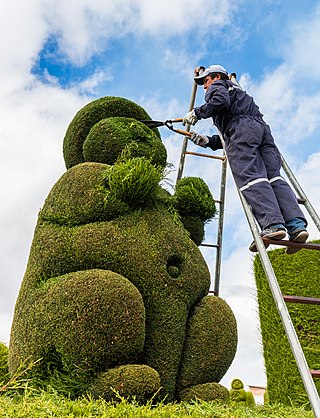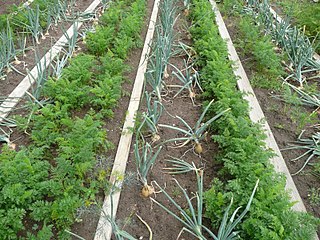Related Research Articles

Gardening is the practice of growing and cultivating plants as part of horticulture. In gardens, ornamental plants are often grown for their flowers, foliage, or overall appearance; useful plants, such as root vegetables, leaf vegetables, fruits, and herbs, are grown for consumption, for use as dyes, or for medicinal or cosmetic use.

Raised-bed gardening is a form of gardening in which the soil is raised above ground level and usually enclosed in some way. Raised bed structures can be made of wood, rock, concrete or other materials, and can be of any size or shape. The soil is usually enriched with compost.

Permaculture is an approach to land management and settlement design that adopts arrangements observed in flourishing natural ecosystems. It includes a set of design principles derived using whole-systems thinking. It applies these principles in fields such as regenerative agriculture, town planning, rewilding, and community resilience. Permaculture originally came from "permanent agriculture", but was later adjusted to mean "permanent culture", incorporating social aspects. The term was coined in 1978 by Bill Mollison and David Holmgren, who formulated the concept in opposition to modern industrialized methods instead adopting a more traditional or "natural" approach to agriculture.

Bruce Charles "Bill" Mollison was an Australian researcher, author, scientist, teacher and biologist. In 1981, he was awarded the Right Livelihood Award "for developing and promoting the theory and practice of permaculture".

Forest gardening is a low-maintenance, sustainable, plant-based food production and agroforestry system based on woodland ecosystems, incorporating fruit and nut trees, shrubs, herbs, vines and perennial vegetables which have yields directly useful to humans. Making use of companion planting, these can be intermixed to grow in a succession of layers to build a woodland habitat. Forest gardening is a prehistoric method of securing food in tropical areas. In the 1980s, Robert Hart coined the term "forest gardening" after adapting the principles and applying them to temperate climates.
No-dig gardening is a non-cultivation method used by some organic gardeners. The origins of no-dig gardening are unclear, and may be based on pre-industrial or nineteenth-century farming techniques. Masanobu Fukuoka started his pioneering research work in this domain in 1938, and began publishing in the 1970s his Fukuokan philosophy of "do-nothing farming" or natural farming, which is now acknowledged by some as the tap root of the permaculture movement. Two pioneers of the method in the twentieth century included F. C. King, Head Gardener at Levens Hall, South Westmorland, in the Lake District of England, who wrote the book "Is Digging Necessary?" in 1946 and a gardener from Middlecliffe in the UK, A. Guest, who in 1948 published the book "Gardening Without Digging". The work of these gardeners was supported by the Good Gardeners Association in the UK. No-dig gardening was also promoted by Australian Esther Deans in the 1970s, and American gardener Ruth Stout advocated a "permanent" garden mulching technique in Gardening Without Work and no-dig methods in the 1950s and 1960s.

Robert Adrian de Jauralde Hart was an English pioneer of forest gardening in temperate zones. He created a model forest garden from a 0.12 acre (500 m²) orchard on his farm. He credits the inspiration for his work to an article by James Sholto Douglas, which was in turn inspired by the work of Toyohiko Kagawa.(page 41)

Groundcover or ground cover is any plant that grows over an area of ground. Groundcover provides protection of the topsoil from erosion and drought.
The following outline is provided as an overview of and topical guide to sustainable agriculture:
David Holmgren is an Australian environmental designer, ecological educator and writer. He is best known as one of the co-originators of the permaculture concept with Bill Mollison.
In agriculture, succession planting refers to several planting methods that increase crop availability during a growing season by making efficient use of space and timing.

A mulch is a layer of material applied to the surface of soil. Reasons for applying mulch include conservation of soil moisture, improving fertility and health of the soil, reducing weed growth and enhancing the visual appeal of the area.

In agriculture, polyculture is the practice of growing more than one crop species in the same space, at the same time. In doing this, polyculture attempts to mimic the diversity of natural ecosystems. Polyculture is the opposite of monoculture, in which only one plant or animal species is cultivated together. Polyculture can improve control of some pests, weeds, and diseases while reducing the need for pesticides. Intercrops of legumes with non-legumes can increase yields on low-nitrogen soils due to biological nitrogen fixation. However, polyculture can reduce crop yields due to competition between the mixed species for light, water, or nutrients. It complicates management as species have different growth rates, days to maturity, and harvest requirements: monoculture is more amenable to mechanisation. For these reasons, many farmers in large-scale agriculture continue to rely on monoculture and use crop rotation to add diversity to the system.
This is an alphabetical index of articles related to gardening.
Plants For A Future (PFAF) is an online not for profit resource for those interested in edible and useful plants, with a focus on temperate regions. Named after the phrase "plans for a future" as wordplay, the organization's emphasis is on perennial plants.
In permaculture, sheet mulching is an agricultural no-dig gardening technique that attempts to mimic the natural soil-building process in forests. When deployed properly and in combination with other permaculture principles, it can generate healthy, productive, and low maintenance ecosystems.

Xeriscaping is the process of landscaping, or gardening, that reduces or eliminates the need for irrigation. It is promoted in regions that do not have accessible, plentiful, or reliable supplies of fresh water and has gained acceptance in other regions as access to irrigation water has become limited, though it is not limited to such climates. Xeriscaping may be an alternative to various types of traditional gardening.

Hügelkultur, literally mound bed or mound culture is a horticultural technique where a mound constructed from decaying wood debris and other compostable biomass plant materials is later planted as a raised bed. Adopted by permaculture advocates, it is suggested the technique helps to improve soil fertility, water retention, and soil warming, thus benefitting plants grown on or near such mounds.

Climate-friendly gardening is a form of gardening that can reduce emissions of greenhouse gases from gardens and encourage the absorption of carbon dioxide by soils and plants in order to aid the reduction of global warming. To be a climate-friendly gardener means considering both what happens in a garden and the materials brought into it and the impact they have on land use and climate. It can also include garden features or activities in the garden that help to reduce greenhouse gas emissions elsewhere.

A community orchard is a collection of fruit trees shared by communities and growing in publicly accessible areas such as public greenspaces, parks, schools, churchyards, allotments or, in the US, abandoned lots. Such orchards are a shared resource and not managed for personal or business profit. Income may be generated to sustain the orchard as a charity, community interest company, or other non-profit structure. What they have in common is that they are cared for by a community of people.